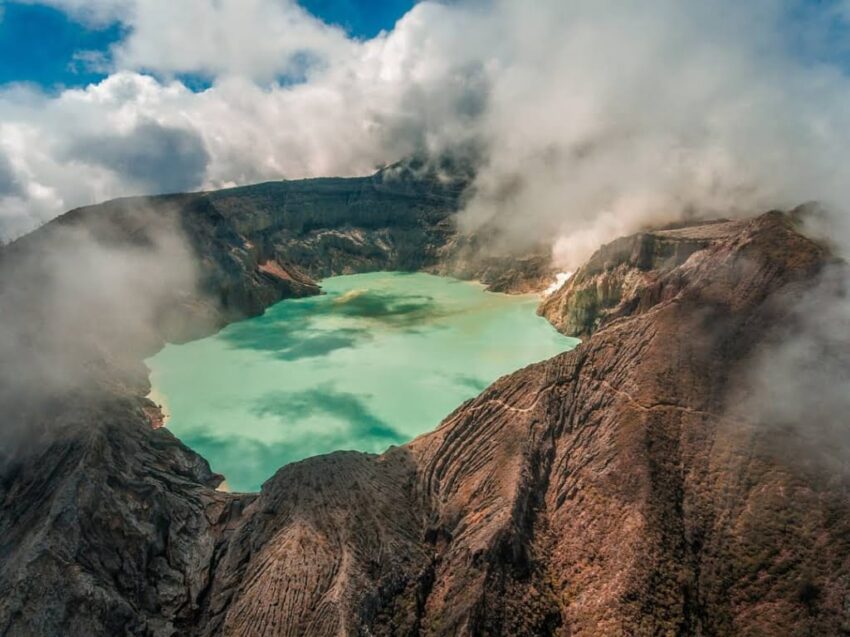Mount Ijen, located in East Java, Indonesia, is one of the most iconic volcanoes in the region, attracting adventurers, photographers, and nature enthusiasts from around the world. Famous for its striking turquoise crater lake and the rare blue fire phenomenon, an expedition to Mount Ijen promises an unforgettable experience. This guide covers essential information about climbing the crater, witnessing the blue fire, and staying safe during your adventure.
Exploring Mount Ijen Crater
The heart of Mount Ijen is its impressive crater, home to the largest acidic crater lake in the world. The lake’s vibrant turquoise color contrasts sharply with the surrounding black volcanic rocks, creating a stunning visual spectacle. Hikers typically begin the ascent from Paltuding, the main entry point, following a winding trail through lush forest and volcanic terrain. The climb, while moderately challenging, is accessible to most visitors with basic fitness levels.
The crater area is an active sulfur mining site, where local miners extract sulfur manually from the vent openings. Witnessing their labor-intensive process adds a cultural and human-interest element to the expedition. However, visitors should maintain a safe distance from mining areas and active fumaroles, as the gases emitted can be hazardous to health.
Also Read: Raffi Ahmad Rebranding
Experiencing the Blue Fire Phenomenon
Mount Ijen is globally renowned for its rare blue fire phenomenon, a natural occurrence that results from sulfuric gases igniting when they emerge from cracks in the volcano at high temperatures. Unlike typical flames, the blue fire is visible mainly at night, emitting an otherworldly glow that photographers and adventurers eagerly seek.
To witness the blue fire, climbers usually start their hike between midnight and 2 a.m., reaching the volcanic ridge before sunrise. This timing allows visitors to experience both the glowing blue fire and the breathtaking view of the sunrise over the crater lake. The combination of the azure flames, misty crater, and rising sun creates a surreal and unforgettable visual experience.
Also Read: Sakti Ari Seno Transformation
Planning Your Climb
Before embarking on a Mount Ijen expedition, proper preparation is essential. The climb can take approximately 2–3 hours to reach the crater rim, depending on your pace. It is advisable to wear sturdy hiking boots and layered clothing, as temperatures near the summit can be significantly cooler than at the base. Carrying a headlamp is crucial for night climbs, both for visibility and safety.
While the hike itself is manageable, altitude and volcanic activity present challenges. Visitors should pace themselves and stay hydrated. Avoid touching sulfur rocks directly, as they can be extremely hot and sharp. Bringing a reusable water bottle and light snacks will make the journey more comfortable.
Safety Considerations
Safety is paramount during a Mount Ijen expedition, particularly because of active volcanic gases and rugged terrain. The most significant risks come from sulfur dioxide exposure, which can cause respiratory issues. It is strongly recommended to use a gas mask or respirator, especially when near fumaroles and mining areas.
Staying on marked trails reduces the risk of accidents. Avoid wandering off-path, as volcanic slopes can be unstable and prone to landslides. Additionally, traveling in groups or hiring a local guide enhances safety and ensures a smoother climbing experience. Guides are knowledgeable about the safest routes, optimal times to see the blue fire, and local weather patterns.
Also Read: Nikita Mirzani vs Dipo Latief Dispute
Responsible Tourism
Visitors to Mount Ijen should practice responsible tourism to preserve the natural and cultural integrity of the area. Avoid littering and respect local miners who work under challenging conditions. Photography is encouraged, but it’s important to maintain safe distances and avoid disturbing mining operations.
Supporting eco-friendly initiatives and local businesses contributes to the sustainability of the region. Many guided tours offer educational insights about volcanic activity, sulfur mining, and conservation efforts, providing a richer and more meaningful experience.
Conclusion
An expedition to Mount Ijen offers a perfect blend of adventure, natural beauty, and cultural immersion. From the turquoise crater lake to the ethereal blue fire phenomenon, the volcano is a unique destination that appeals to both thrill-seekers and photographers. Proper planning, safety precautions, and respect for the environment are essential to make the most of your journey. Whether you’re chasing the glow of the blue fire or marveling at the crater’s vibrant colors, Mount Ijen promises memories that last a lifetime.
